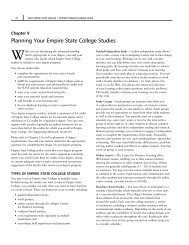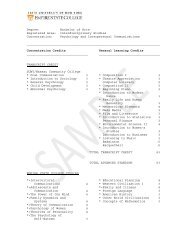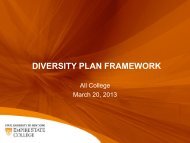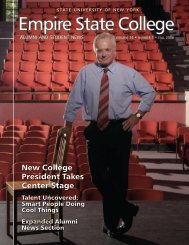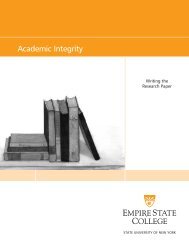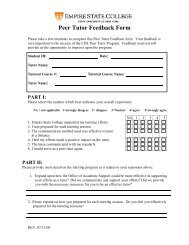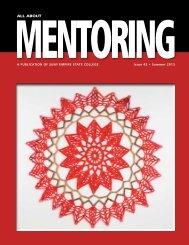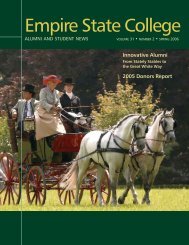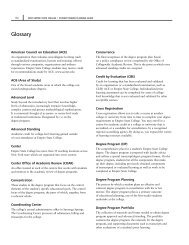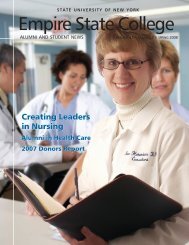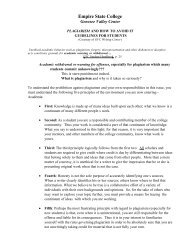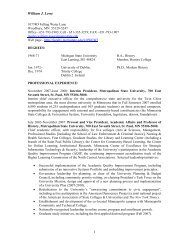Academic Plan 2011-2015 (PDF 524kB) - SUNY Empire State College
Academic Plan 2011-2015 (PDF 524kB) - SUNY Empire State College
Academic Plan 2011-2015 (PDF 524kB) - SUNY Empire State College
Create successful ePaper yourself
Turn your PDF publications into a flip-book with our unique Google optimized e-Paper software.
<strong>SUNY</strong> <strong>Empire</strong> <strong>State</strong> <strong>College</strong>: <strong>Academic</strong> <strong>Plan</strong> <strong>2011</strong> - <strong>2015</strong> 35Distribution of faculty among programsWe need to document the distribution of faculty among programs, including formal sharedappointments and informal cross-center and program mentoring. For example, it is important toknow how many faculty are doing a significant amount of work with students outside of theirown location or program and whether or how it might be recognized. While another task forceis working to develop new models for distributing faculty expertise across the college, answersto these questions should inform that work.Faculty expertise in practice-based knowledge and how we identify “experts”We need to determine who has “expertise” in individual degree planning at the undergraduatelevel among the faculty and who has “expertise” in working with Master of Arts in LiberalStudies (MALS) students in the design of programs. Again, we need to develop a processto determine expertise or other specialized practice-based knowledge that is determinedto be critical.Faculty evaluation of experiential learningThere is a need to determine the proportion of full-time faculty, part-time faculty and outsideevaluators who are engaged in developing and assessing prior learning. Moreover, thedistribution of prior learning assessment (PLA) requests across subject expertise is critical todetermining where additional resources might be needed. It also would be useful to know whois helping learners develop their experiential learning requests, including full-time faculty, parttimefaculty and/or outside evaluators.Objective C1.2: Analyze and recommend optimal configurations to meet the current andproposed needs of the collegeOnce the current state of the faculty is known, there are two basic questions: how well does thecurrent faculty serve the needs of current students, and how can the future faculty serve the needs offuture students?Current faculty serving current studentsWe need to determine whether we currently are meeting the needs of our students by subjectarea, in terms of whether there are gaps in service delivery. The college’s plan for faculty hiringneeds to be evaluated in terms of whether to continue to utilize the model of having at least onefull-time subject matter specialist per AOS in each regional center, or to consider developing anew and different model for hiring. It is critical to determine an effective means of identifyingan optimal configuration of current faculty across all subject areas or identified trends in studentinterests. Critical consideration needs to be given to the role of full- and part-time faculty, as wellas adjuncts and professional employees.Future faculty serving future studentsAnticipated student needs should be considered in faculty planning at the college. In addition,it is critical to ensure that the current faculty complement is sufficient to meet the workloadneeds of the college. Strategic planning needs to play a role in how that faculty complementcan or should change as the anticipated growth unfolds over the next five years. It is critical




